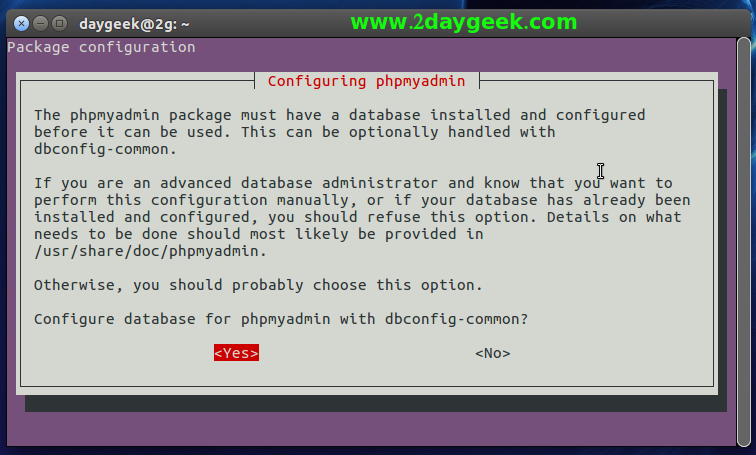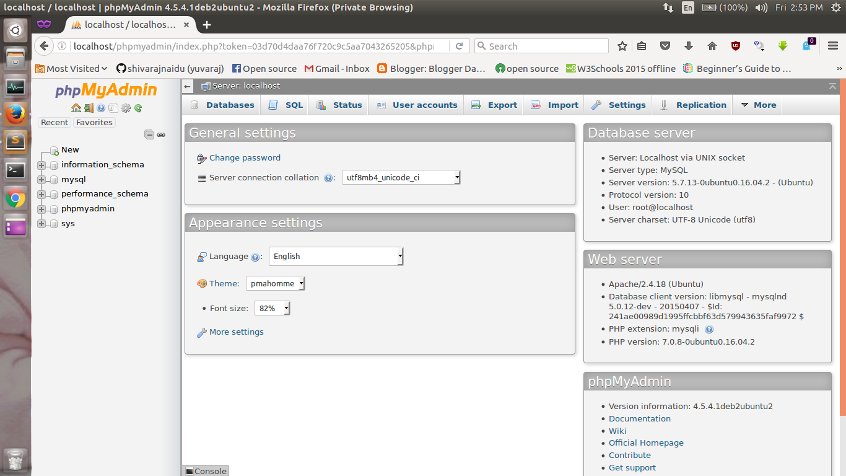

- #Install phpmyadmin ubuntu install#
- #Install phpmyadmin ubuntu update#
- #Install phpmyadmin ubuntu software#
- #Install phpmyadmin ubuntu code#
- #Install phpmyadmin ubuntu password#
$ sudo unzip phpMyAdmin-4.8.4-all-languages.zip
#Install phpmyadmin ubuntu install#
The easiest way to do this is to use the unzip tool: $ sudo apt install unzip If there's a newer version available than 4.8.4 (you can on their website), then change the link above to suit. Download and InstallĪfter logging into your server, change directory to /usr/share (the traditional place for phpMyAdmin to be stored) and download the files: $ cd /usr/share The latest version of phpMyAdmin at the time of writing is 4.8.4. The server I'm using is running Ubuntu 18.04 (though this tutorial will likely need little to no revision for previous versions), Apache 2.4.37, MySQL 8.0.13, and PHP 7.2.14. Whatever the reason, this tutorial will run you through the basic process of doing so. You also may just want the latest version for the virtues that come with staying up-to-date. This might be because you're using MySQL 8 and/or PHP 7 and the version provided by Ubuntu's apt repository either won't install or won't function with this setup. Tested on Debian 12.Sometimes installing phpMyAdmin manually, as opposed to using apt, is necessary. And the source install part has been re-written in 2023 by William following the phpMyAdmin documentation. Now that the configuration is done, navigate to: Note: This guide has been tested on Ubuntu 6.06 (Dapper), Ubuntu 7.10 (Gutsy), and Ubuntu 8.04 (Hardy). Write it into in the phpMyAdmin-STABLE folder.Ĭopy to and make the necessary adjustments. When your configuration file is ready you can click "Download" or copy the generated code. Navigate to in your browser and follow the instructions. To also have other languages than English you will need to install gettext and run.
#Install phpmyadmin ubuntu code#
Install the JS tools and build the source code yarnpkg install -production
#Install phpmyadmin ubuntu update#
Install the composer vendor modules composer update -no-dev Then cd to phpMyAdmin: cd phpMyAdmin-STABLE Then download it using git by writing: git clone -b STABLE phpMyAdmin-STABLE To install it from source, open the console and cd to the www directory using: cd /var/www/html You will also need Composer and Yarn (package: yarnpkg) to build the generated files. Also, you'll need to have Git installed to download the source.

This is not recommended for a production web server. This method circumvents the package manager and you will need to install updates yourself. Sudo ln -s /etc/phpmyadmin/nf /etc/apache2/conf-available/nf Therefore, if you need to manually include the phpMyAdmin-shipped Apache configuration file, you must run the following:

Instead, they are placed in the /etc/apache2/conf-available directory which is managed with the a2enconf command.
#Install phpmyadmin ubuntu password#
If no users have been setup, try root with no password to login. You should be able to login using any users you've setup in MySQL. Once phpMyAdmin is installed point your browser to to start using it.

You can also skip the set up step and go directly to and login with the user and password you set up during install. If you are using Ubuntu 9.04 (Jaunty), there is no need to modify /etc/apache2/nf as the package installer already copied the file nf into /etc/apache2/conf.d directory. To set up under Apache all you need to do is include the following line in /etc/apache2/nf. If you're using Ubuntu 7.10 (Gutsy) or later select Apache2 from the "Configuring phpmyadmin" dialog box. (Note, however, that installation from a package manager often does not work).įrom console: sudo apt-get install phpmyadmin See InstallingSoftware for detailed instructions on using repositories and package managers. Install phpMyAdmin from the Universe repository. To use it, you'll need to install and configure Apache, PHP, and the PHP mysqli extension.
#Install phpmyadmin ubuntu software#
PhpMyAdmin is a very popular MySQL management software package.


 0 kommentar(er)
0 kommentar(er)
